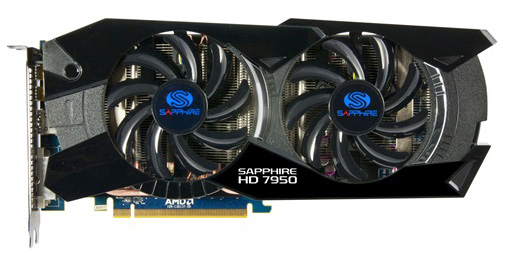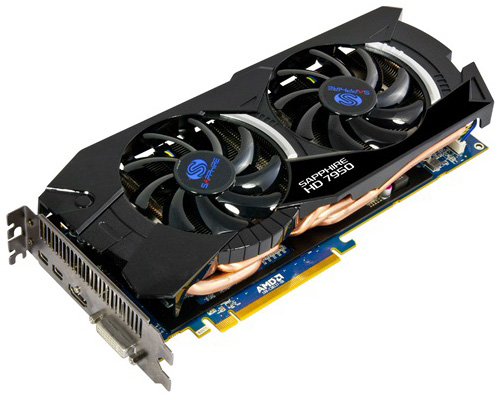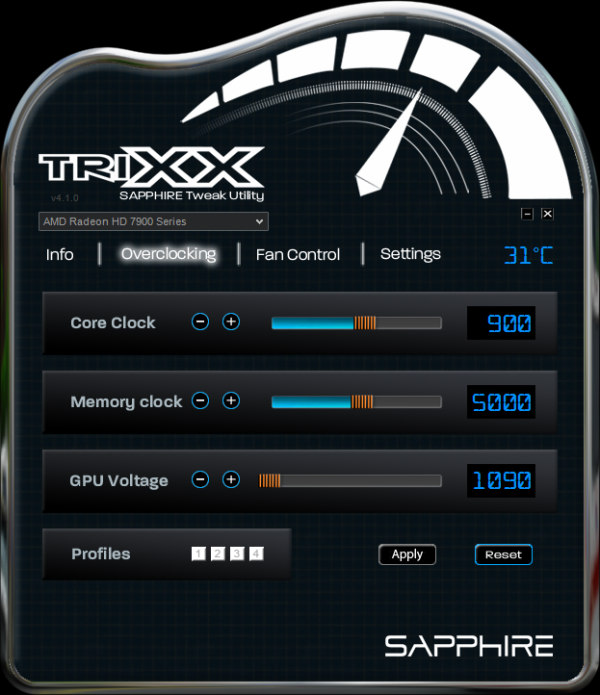AMD Radeon HD 7950 Review Feat. Sapphire & XFX: Sewing Up The High-End Market
by Ryan Smith on January 31, 2012 9:02 AM ESTMeet the Sapphire HD 7950 Overclock Edition
Since our reference 7950s are built on the 7970 PCB and cooler, we’re going to jump right into our vendor cards starting with the Sapphire HD 7950 Overclock Edition.
As with all of the 7950 cards launching today, Sapphire’s HD 7950 Overclock Edition uses the AMD 7950 PCB. This is a slightly shorter PCB measuring 10.25” long, saving .25” over the 7970 PCB by eliminating a few components that the lower board power of the 7950 makes unnecessary. The PCB is otherwise very similar to the 7970 PCB, utilizing 12 GDDR5 memory chips organized around the Tahiti GPU, while at the top you’ll find the 2 CrossFire connectors, a pair of 6pin PCIe power sockets, and the BIOS selection switch. The latter will be of particular interest to unlockers, as the switch should make it possible to safely attempt to unlock the 7950 into a 7970.

Moving on, as this is a semi-custom card the real differentiation is in the factory overclock and the cooler. On the performance side of things Sapphire will be shipping the 7950 Overclock Edition at 900MHz core and 5GHz memory, representing a 100MHz (12.5%) core overclock and no change on the memory clock.
Meanwhile for the cooler Sapphire is using what they’re calling the Dual-X cooler. The Dual-X is yet another double-wide dual-fan open air cooler, with 2 fans providing copious airflow over an aluminum heatsink running virtually the entire length of the card. Sapphire’s fan cutouts are just a bit bigger than most other dual-fan coolers and placed a bit higher, and as a result the Dual-X cooler is a bit taller than the PCB by about 15mm at its highest point. Meanwhile the cooler is also a fair bit longer than the PCB, putting the total card length at 11”.
Moving below the fans and the heatsink we’ll find the heatpipe assembly, which is responsible for carrying heat from the GPU to the heatsink. The Dual-X uses 5 copper heatpipes of varying radius that run from one end of the heatsink to the other. The 5 heatpipes converge at the base of the assembly, where a copper baseplate provides contact with the GPU. Meanwhile cooling for the VRM MOSFETs and RAM is provided by a black aluminum plate, which is placed over those components with heat transfer provided by the use of thermal pads. There is no connection between the plate and the heatsink, so the only heat dissipation from the plate is provided by whatever airflow from the fans reaches the plate.

At the front of the card we’ll find the display ports, which as this is an AMD PCB the card utilizes the standard AMD 7000 series port configuration of 1 DL-DVI port, 1 HDMI port, and 2 mini-DisplayPorts. Filling out the second slot is the grating for ventilation, though even with the ventilation slot the usual precautions for an open-air cooler apply: you’ll need a case with enough airflow to handle the roughly 200W of heat the card is capable of dumping inside of your case.
Rounding out the package is the usual collection of dongles and materials. Sapphire includes 2 molex-to-6pin PCIe adaptors, an HDMI to DVI dongle, a miniDP to DisplayPort dongle, a DVI to VGA dongle, and a 1.8m HDMI cable. Along with the dongles Sapphire packs a quick start guide and a driver installation CD.
The only thing you won’t find packed in the box is TriXX, Sapphire’s in-house overclocking utility. TriXX has been around since the 6900 series, but as this is the first high-end Sapphire card we’ve reviewed since it was released, this is the first time we’ve had it available for a review.
Fundamentally TriXX is a fairly well designed, albeit barebones overclocking utility. Along with an info readout similar to GPU-Z, TriXX provides overclocking and fan control support for Sapphire’s cards, including support for custom fan profiles and more importantly voltage control. With TriXX it’s possible to overvolt most of Sapphire’s performance and high-end cards, and as Sapphire uses AMD reference PCBs it also works with any other cards using AMD’s PCBs.
Beyond these features there’s little more to TriXX. It’s not an all-encompassing video card utility like MSI’s Afterburner, which means it comes up short if you need more functionality but it's exactly what you need if you just want to overclock. To that end it’s a clear step up compared to most other manufacturer’s poorly designed utilities, and from a design perspective its only real sin is the hard to read blue-on-black text. Otherwise it’s a competent overclocking utility that does exactly what it’s supposed to and provides voltage control for those who need it.
Finally, Sapphire will be selling the 7950 OE for $479, $30 over the baseline 7950 MSRP. Meanwhile the warranty on their card is their standard 2 year warranty.















259 Comments
View All Comments
MattM_Super - Tuesday, January 31, 2012 - link
Yes I would enjoy more performance (esp at a lower power draw). I like to get ~60fps minimum @1080p. In games with fancy lighting effects, 4xAA, high res textures, like Witcher 2, metro 2033, crysis 2 dx11 current cards cant deliver that. Its a luxury sure, but one I am willing to pay for.I also think there is still plenty of room for improvement in graphics.
sleepeeg3 - Wednesday, February 15, 2012 - link
Bingo. The fanboys are too focused on bickering to realize these GPUs are blowing past 100fps on popular games. Who cares? Game companies stopped pushing the limits years ago.chizow - Tuesday, January 31, 2012 - link
Its funny because next-gen single-GPU performance *USED* to be measured against previous gen x2 GPU card or CF/SLI where we would expect 50+% increase over last-gen single-GPU.But yes its easy to ignore the fact the 580 also overclocks quite well. I don't know what would be worst though for a new 7950 or 7970 owner. Kepler launching and make these prices look like tragic comedy, or AMD releasing the HD89xx not too long after to make them feel even worst about their purchase.
Either way, you make a compelling argument against buying one of these cards today.
Master_shake_ - Tuesday, January 31, 2012 - link
you are obviously a fanboy,obviously you missed the part where the 7970 can oc to 1125 on the cvore and max out the vram clock with STOCK voltiage, and when you do so it beats BEATS the gtx 590 a current gen dual gpu card.
chizow - Tuesday, January 31, 2012 - link
While I value OC'ability, I don't consider OC to stock comparisons relevant because frankly, it makes no sense.Every card can OC to some degree so an apples-to-apples comparison should be the primary comparison with overclockability secondary.
Tchamber - Wednesday, February 1, 2012 - link
Rather than call you a fanboy, I would ask for an example of a high end card going against the previous gen x2 card...and bear in mind that ONCE does NOT consitute a trend. I think evolution of performance is always incremental, at least is has been since gtx200 and radeon 4000 series.chizow - Wednesday, February 1, 2012 - link
-GTX 280 was very close to as fast as 9800GX2Filter prevented a link for this, but google computerbase GTX 280 review and look at performance rating summary.
-GTX 480/580 was faster than GTX 295
Same deal, google 480 review for that site.
-GTX 680 should be very close to GTX 590 performance
What makes this easier on the next-gen GPU flagship is the last-gen X2 parts generally have to make sacrifices in either bandwidth, functional units, or clockspeeds to stay within TDP envelopes along with imperfect multi-GPU scaling, so you generally see only 50-75% scaling over the top single-GPU of that generation.
So you can look at it two ways, either next-gen should be ~50% faster than the top last-gen GPU, or it is very close to the last-gen X2 GPU card.
I'm trying not to take any shots at AMD fans, but their reactions to these Tahiti parts in light of historical price and performance leads me to believe they either have very low standards/expectations or they just haven't been paying attention to the industry.
Galidou - Saturday, February 4, 2012 - link
''they just haven't been paying attention to the industry''Wait, if I buy a GPU now, and I want the top single gpu for multiple screens, whatever the people in the world think about what I WANT, I realize that I have more power for my money by buying a 7970 and I go with it, it turns out that because I have done that, I'm an AMD fanboy because I haven'T been paying attention to the industry?
OMG I'm such a tard, I forgot I haven'T paid attention to the industry so I should of paid more for a less performing card..... darn that's how stupid I am.....
chizow - Saturday, February 4, 2012 - link
If you absolutely had to have a new card today, sure you'd have some reason to buy a 7970, but still not at these prices imo.If you wanted to maximize your return on the dollar however, you'd be much better off waiting for Kepler because even if the 7970 still suits your needs better at that point, Kepler will almost assuredly force downward pressure on all Tahiti AND Fermi parts and force AMD and Nvidia to adjust prices accordingly. In the past AMD has done this when they launched a next-gen part first (See: 5850/5870 launch), but not this time.
This actually reminds me a lot of the X1950XTX launch. Great performance when it launched and price perfectly justified compared to Nvidia's last-gen G70/G71 designs like 7900GTX and 7950GT. But as soon as G80/8800GTX launched a few months later, it made that buy decision look horrible in retrospect.
So yes, while a X1950XTX today, er I mean 7970 today looks perfectly justified, it would be a mistake to ignore what the future holds and what the past has told us when making a buying decision.
Galidou - Sunday, February 5, 2012 - link
What about the pricing of gtx 280 at launch vs the price of 8800gt were selling? There's always an example about Ati making bad pricing decisions, but nvidia... not out of your mouth?I'm no ATI fanboy, I'm just waiting for you to show us you see the other side of the medal...
Those GTX 280 650$ at launch while the 8800gt was about 55-65% of the performance of that card but HEY it was three times cheaper... No you haven't heard of? Oh I forgot, Nvidia makes no mistakes, it's ATI that did with the 4870 pricing it so low, but Nvidia... they make no mistake.
But hey the price of the 7970 accordingly to it'S performance is SO BAD compared to the triple price of that GTX 280 for not even double the performance over that nice 8800gt...